“英语”高效课堂讲座稿
- 格式:doc
- 大小:32.50 KB
- 文档页数:5
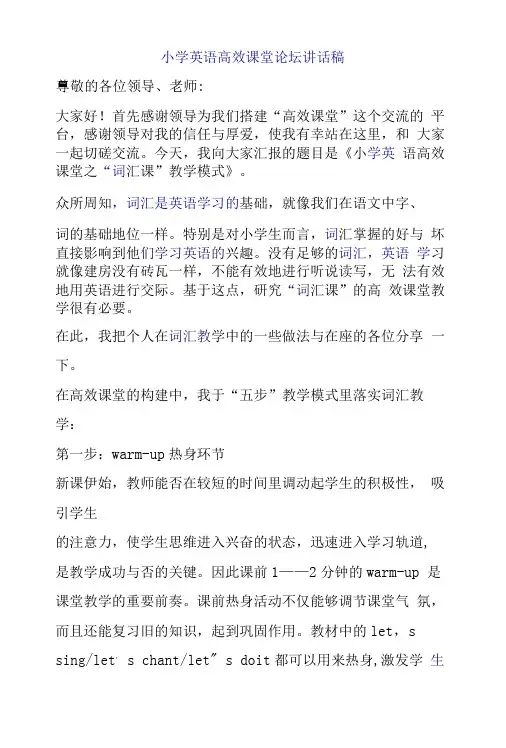
小学英语高效课堂论坛讲话稿大家好!首先感谢领导为我们搭建“高效课堂”这个交流的 平台,感谢领导对我的信任与厚爱,使我有幸站在这里,和 大家一起切磋交流。
今天,我向大家汇报的题目是《小学英 语高效课堂之“词汇课”教学模式》。
众所周知,词汇是英语学习的基础,就像我们在语文中字、 词的基础地位一样。
特别是对小学生而言,词汇掌握的好与 坏直接影响到他们学习英语的兴趣。
没有足够的词汇,英语 学习就像建房没有砖瓦一样,不能有效地进行听说读写,无 法有效地用英语进行交际。
基于这点,研究“词汇课”的高 效课堂教学很有必要。
在此,我把个人在词汇教学中的一些做法与在座的各位分享 一下。
在高效课堂的构建中,我于“五步”教学模式里落实词汇教 学:第一步:warm-up 热身环节新课伊始,教师能否在较短的时间里调动起学生的积极性, 吸引学生的注意力,使学生思维进入兴奋的状态,迅速进入学习轨道, 是教学成功与否的关键。
因此课前1——2分钟的warm-up 是课堂教学的重要前奏。
课前热身活动不仅能够调节课堂气 氛,而且还能复习旧的知识,起到巩固作用。
教材中的let ,s sing/let ,s chant/let" s doit 都可以用来热身,激发学 生:学习英语的兴趣和热情,也可以通过free talk的形式与学生交谈,拉近师生关系,营造英语学习氛围。
本环节的教学原则是:热身活动要与本堂课的教学内容有关,衔接新旧知识,激发学生学习兴趣。
第二步:revision复习环节复习与本课有关的内容,设计活泼、新颖、有趣的教学活动与新知巧妙结合,唤起学生对已有知识的记忆,调动学生的学习热情,既检查了旧知识的掌握情况,又为新课做好铺垫。
这一环节的教学原则是:针对新知识进行复习,复习的内容要与新知识紧密衔接,并通过旧知识的复习自然过渡到新知识的学习。
复习的方法可以有多种:1.通过游戏进行复习。
如I: listen and touch,听单词触摸图片,看谁先摸到所听的图片。
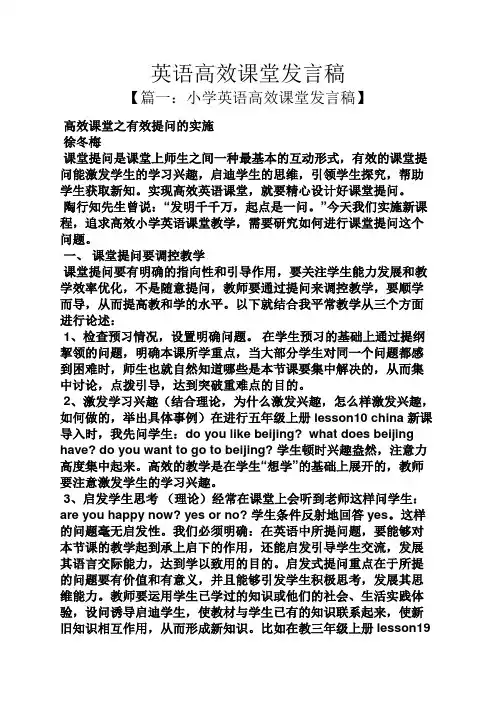
英语高效课堂发言稿【篇一:小学英语高效课堂发言稿】高效课堂之有效提问的实施徐冬梅课堂提问是课堂上师生之间一种最基本的互动形式,有效的课堂提问能激发学生的学习兴趣,启迪学生的思维,引领学生探究,帮助学生获取新知。
实现高效英语课堂,就要精心设计好课堂提问。
陶行知先生曾说:“发明千千万,起点是一问。
”今天我们实施新课程,追求高效小学英语课堂教学,需要研究如何进行课堂提问这个问题。
一、课堂提问要调控教学课堂提问要有明确的指向性和引导作用,要关注学生能力发展和教学效率优化,不是随意提问,教师要通过提问来调控教学,要顺学而导,从而提高教和学的水平。
以下就结合我平常教学从三个方面进行论述:1、检查预习情况,设置明确问题。
在学生预习的基础上通过提纲挈领的问题,明确本课所学重点,当大部分学生对同一个问题都感到困难时,师生也就自然知道哪些是本节课要集中解决的,从而集中讨论,点拨引导,达到突破重难点的目的。
2、激发学习兴趣(结合理论,为什么激发兴趣,怎么样激发兴趣,如何做的,举出具体事例)在进行五年级上册lesson10 china 新课导入时,我先问学生:do you like beijing? what does beijing have? do you want to go to beijing? 学生顿时兴趣盎然,注意力高度集中起来。
高效的教学是在学生“想学”的基础上展开的,教师要注意激发学生的学习兴趣。
3、启发学生思考(理论)经常在课堂上会听到老师这样问学生:are you happy now? yes or no? 学生条件反射地回答yes。
这样的问题毫无启发性。
我们必须明确:在英语中所提问题,要能够对本节课的教学起到承上启下的作用,还能启发引导学生交流,发展其语言交际能力,达到学以致用的目的。
启发式提问重点在于所提的问题要有价值和有意义,并且能够引发学生积极思考,发展其思维能力。
教师要运用学生已学过的知识或他们的社会、生活实践体验,设问诱导启迪学生,使教材与学生已有的知识联系起来,使新旧知识相互作用,从而形成新知识。
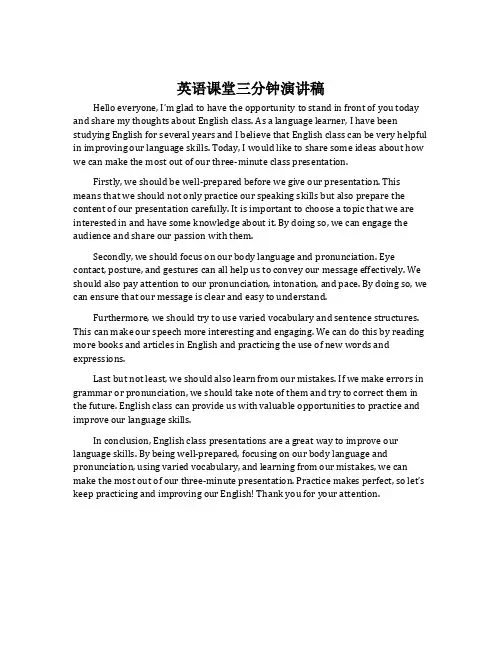
英语课堂三分钟演讲稿Hello everyone, I’m glad to have the opportunity to stand in front of you today and share my thoughts about English class. As a language learner, I have been studying English for several years and I believe that English class can be very helpful in improving our language skills. Today, I would like to share some ideas about how we can make the most out of our three-minute class presentation.Firstly, we should be well-prepared before we give our presentation. This means that we should not only practice our speaking skills but also prepare the content of our presentation carefully. It is important to choose a topic that we are interested in and have some knowledge about it. By doing so, we can engage the audience and share our passion with them.Secondly, we should focus on our body language and pronunciation. Eye contact, posture, and gestures can all help us to convey our message effectively. We should also pay attention to our pronunciation, intonation, and pace. By doing so, we can ensure that our message is clear and easy to understand.Furthermore, we should try to use varied vocabulary and sentence structures. This can make our speech more interesting and engaging. We can do this by reading more books and articles in English and practicing the use of new words and expressions.Last but not least, we should also learn from our mistakes. If we make errors in grammar or pronunciation, we should take note of them and try to correct them in the future. English class can provide us with valuable opportunities to practice and improve our language skills.In conclusion, English class presentations are a great way to improve our language skills. By being well-prepared, focusing on our body language and pronunciation, using varied vocabulary, and learning from our mistakes, we can make the most out of our three-minute presentation. Practice makes perfect, so let’s keep practicing and improving our English! Thank you for your attention.。
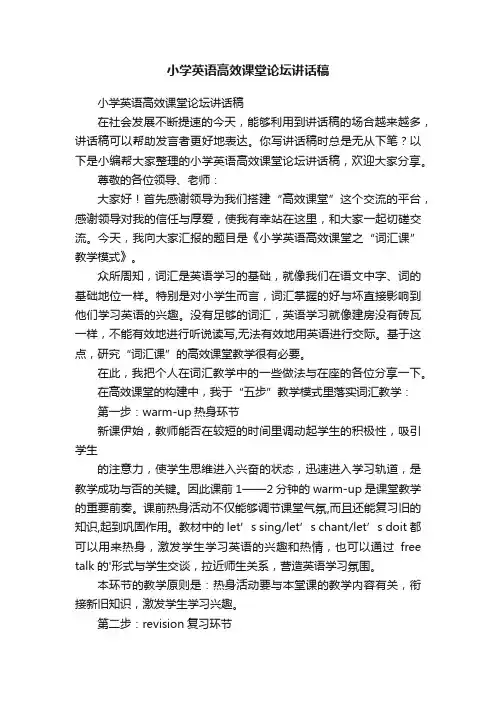
小学英语高效课堂论坛讲话稿小学英语高效课堂论坛讲话稿在社会发展不断提速的今天,能够利用到讲话稿的场合越来越多,讲话稿可以帮助发言者更好地表达。
你写讲话稿时总是无从下笔?以下是小编帮大家整理的小学英语高效课堂论坛讲话稿,欢迎大家分享。
尊敬的各位领导、老师:大家好!首先感谢领导为我们搭建“高效课堂”这个交流的平台,感谢领导对我的信任与厚爱,使我有幸站在这里,和大家一起切磋交流。
今天,我向大家汇报的题目是《小学英语高效课堂之“词汇课”教学模式》。
众所周知,词汇是英语学习的基础,就像我们在语文中字、词的基础地位一样。
特别是对小学生而言,词汇掌握的好与坏直接影响到他们学习英语的兴趣。
没有足够的词汇,英语学习就像建房没有砖瓦一样,不能有效地进行听说读写,无法有效地用英语进行交际。
基于这点,研究“词汇课”的高效课堂教学很有必要。
在此,我把个人在词汇教学中的一些做法与在座的各位分享一下。
在高效课堂的构建中,我于“五步”教学模式里落实词汇教学:第一步:warm-up热身环节新课伊始,教师能否在较短的时间里调动起学生的积极性,吸引学生的注意力,使学生思维进入兴奋的状态,迅速进入学习轨道,是教学成功与否的关键。
因此课前1——2分钟的warm-up是课堂教学的重要前奏。
课前热身活动不仅能够调节课堂气氛,而且还能复习旧的知识,起到巩固作用。
教材中的let’s sing/let’s chant/let’s doit都可以用来热身,激发学生学习英语的兴趣和热情,也可以通过free talk的'形式与学生交谈,拉近师生关系,营造英语学习氛围。
本环节的教学原则是:热身活动要与本堂课的教学内容有关,衔接新旧知识,激发学生学习兴趣。
第二步:revision复习环节复习与本课有关的内容,设计活泼、新颖、有趣的教学活动与新知巧妙结合,唤起学生对已有知识的记忆,调动学生的学习热情,既检查了旧知识的掌握情况,又为新课做好铺垫。
这一环节的教学原则是:针对新知识进行复习,复习的内容要与新知识紧密衔接,并通过旧知识的复习自然过渡到新知识的学习。
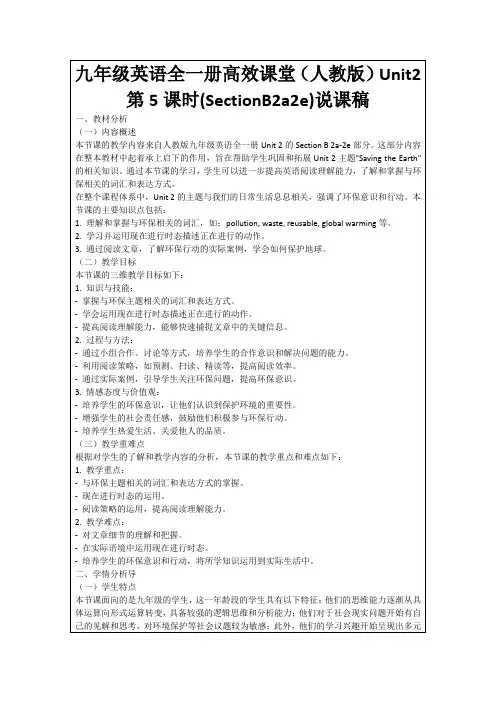
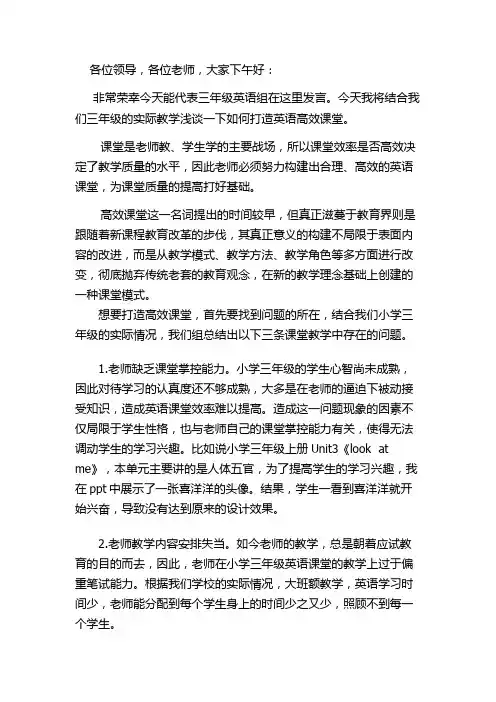
各位领导,各位老师,大家下午好:非常荣幸今天能代表三年级英语组在这里发言。
今天我将结合我们三年级的实际教学浅谈一下如何打造英语高效课堂。
课堂是老师教、学生学的主要战场,所以课堂效率是否高效决定了教学质量的水平,因此老师必须努力构建出合理、高效的英语课堂,为课堂质量的提高打好基础。
高效课堂这一名词提出的时间较早,但真正滋蔓于教育界则是跟随着新课程教育改革的步伐,其真正意义的构建不局限于表面内容的改进,而是从教学模式、教学方法、教学角色等多方面进行改变,彻底抛弃传统老套的教育观念,在新的教学理念基础上创建的一种课堂模式。
想要打造高效课堂,首先要找到问题的所在,结合我们小学三年级的实际情况,我们组总结出以下三条课堂教学中存在的问题。
1.老师缺乏课堂掌控能力。
小学三年级的学生心智尚未成熟,因此对待学习的认真度还不够成熟,大多是在老师的逼迫下被动接受知识,造成英语课堂效率难以提高。
造成这一问题现象的因素不仅局限于学生性格,也与老师自己的课堂掌控能力有关,使得无法调动学生的学习兴趣。
比如说小学三年级上册Unit3《look at me》,本单元主要讲的是人体五官,为了提高学生的学习兴趣,我在ppt中展示了一张喜洋洋的头像。
结果,学生一看到喜洋洋就开始兴奋,导致没有达到原来的设计效果。
2.老师教学内容安排失当。
如今老师的教学,总是朝着应试教育的目的而去,因此,老师在小学三年级英语课堂的教学上过于偏重笔试能力。
根据我们学校的实际情况,大班额教学,英语学习时间少,老师能分配到每个学生身上的时间少之又少,照顾不到每一个学生。
3.课堂评价注重终结式评价。
目前小学英语课堂存在较为明显的一个问题,即为英语课堂评价问题,单一的评价方式、终结式的评价语言,根本无法明显告知学生的英语学习问题,反而造成了部分学生学习的盲目,一定程度上降低了学生的学习热情与特长的发挥。
结合以上问题我们想出了以下4条解决方法:1.合理调控英语课堂。
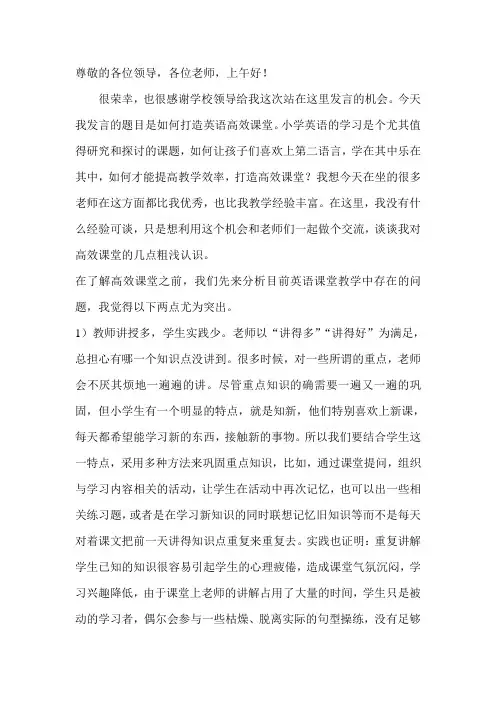
尊敬的各位领导,各位老师,上午好!很荣幸,也很感谢学校领导给我这次站在这里发言的机会。
今天我发言的题目是如何打造英语高效课堂。
小学英语的学习是个尤其值得研究和探讨的课题,如何让孩子们喜欢上第二语言,学在其中乐在其中,如何才能提高教学效率,打造高效课堂?我想今天在坐的很多老师在这方面都比我优秀,也比我教学经验丰富。
在这里,我没有什么经验可谈,只是想利用这个机会和老师们一起做个交流,谈谈我对高效课堂的几点粗浅认识。
在了解高效课堂之前,我们先来分析目前英语课堂教学中存在的问题,我觉得以下两点尤为突出。
1)教师讲授多,学生实践少。
老师以“讲得多”“讲得好”为满足,总担心有哪一个知识点没讲到。
很多时候,对一些所谓的重点,老师会不厌其烦地一遍遍的讲。
尽管重点知识的确需要一遍又一遍的巩固,但小学生有一个明显的特点,就是知新,他们特别喜欢上新课,每天都希望能学习新的东西,接触新的事物。
所以我们要结合学生这一特点,采用多种方法来巩固重点知识,比如,通过课堂提问,组织与学习内容相关的活动,让学生在活动中再次记忆,也可以出一些相关练习题,或者是在学习新知识的同时联想记忆旧知识等而不是每天对着课文把前一天讲得知识点重复来重复去。
实践也证明:重复讲解学生已知的知识很容易引起学生的心理疲倦,造成课堂气氛沉闷,学习兴趣降低,由于课堂上老师的讲解占用了大量的时间,学生只是被动的学习者,偶尔会参与一些枯燥、脱离实际的句型操练,没有足够的主动参与、体验、实践的机会和时间,学生学不会,各项技能得不到应有的训练和发展,课堂效率低。
2)活动形式多,实际收效少。
课堂活动形式花样很多,但效果却不尽人意。
问题比较突出的就是:小组合作学习。
讨论过程、反馈,都只有少数尖子生参与、表现,大部分学生没有真正参与。
突出学生的主体地位不是只突出尖子生的主体地位,课堂教学应面向全体.那么什么样的课堂才叫高效呢?高效课堂是建立在有效教学基础之上的。
它是由教师和学生合力打造而成的,有意义有效率扎实的,有内容的能给人以启迪的课,而不是只图热闹的课。
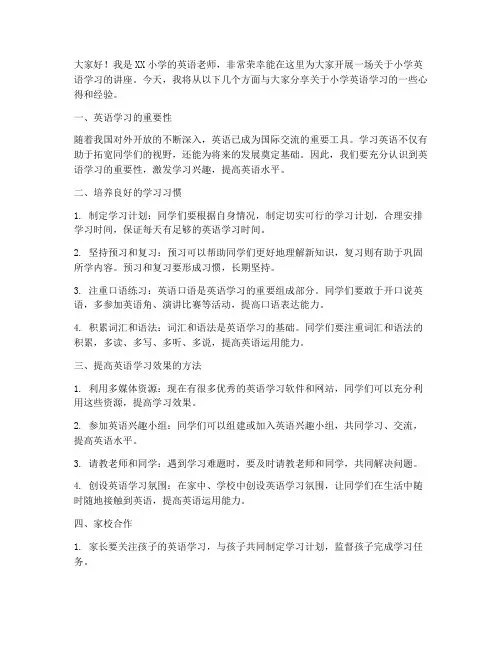
大家好!我是XX小学的英语老师,非常荣幸能在这里为大家开展一场关于小学英语学习的讲座。
今天,我将从以下几个方面与大家分享关于小学英语学习的一些心得和经验。
一、英语学习的重要性随着我国对外开放的不断深入,英语已成为国际交流的重要工具。
学习英语不仅有助于拓宽同学们的视野,还能为将来的发展奠定基础。
因此,我们要充分认识到英语学习的重要性,激发学习兴趣,提高英语水平。
二、培养良好的学习习惯1. 制定学习计划:同学们要根据自身情况,制定切实可行的学习计划,合理安排学习时间,保证每天有足够的英语学习时间。
2. 坚持预习和复习:预习可以帮助同学们更好地理解新知识,复习则有助于巩固所学内容。
预习和复习要形成习惯,长期坚持。
3. 注重口语练习:英语口语是英语学习的重要组成部分。
同学们要敢于开口说英语,多参加英语角、演讲比赛等活动,提高口语表达能力。
4. 积累词汇和语法:词汇和语法是英语学习的基础。
同学们要注重词汇和语法的积累,多读、多写、多听、多说,提高英语运用能力。
三、提高英语学习效果的方法1. 利用多媒体资源:现在有很多优秀的英语学习软件和网站,同学们可以充分利用这些资源,提高学习效果。
2. 参加英语兴趣小组:同学们可以组建或加入英语兴趣小组,共同学习、交流,提高英语水平。
3. 请教老师和同学:遇到学习难题时,要及时请教老师和同学,共同解决问题。
4. 创设英语学习氛围:在家中、学校中创设英语学习氛围,让同学们在生活中随时随地接触到英语,提高英语运用能力。
四、家校合作1. 家长要关注孩子的英语学习,与孩子共同制定学习计划,监督孩子完成学习任务。
2. 家长要鼓励孩子参加英语活动,为孩子提供良好的学习环境。
3. 家长要关注孩子的心理变化,及时与老师沟通,共同帮助孩子解决学习中的问题。
总之,小学英语学习是一个长期的过程,需要同学们、家长和老师的共同努力。
希望同学们能够珍惜学习机会,养成良好的学习习惯,提高英语水平,为未来的发展打下坚实基础。
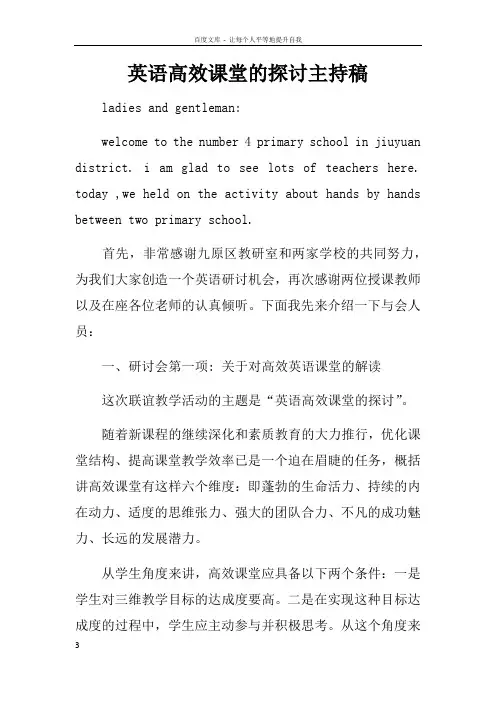
英语高效课堂的探讨主持稿ladies and gentleman:welcome to the number 4 primary school in jiuyuan district. i am glad to see lots of teachers here. today ,we held on the activity about hands by hands between two primary school.首先,非常感谢九原区教研室和两家学校的共同努力,为我们大家创造一个英语研讨机会,再次感谢两位授课教师以及在座各位老师的认真倾听。
下面我先来介绍一下与会人员:一、研讨会第一项: 关于对高效英语课堂的解读这次联谊教学活动的主题是“英语高效课堂的探讨”。
随着新课程的继续深化和素质教育的大力推行,优化课堂结构、提高课堂教学效率已是一个迫在眉睫的任务,概括讲高效课堂有这样六个维度:即蓬勃的生命活力、持续的内在动力、适度的思维张力、强大的团队合力、不凡的成功魅力、长远的发展潜力。
从学生角度来讲,高效课堂应具备以下两个条件:一是学生对三维教学目标的达成度要高。
二是在实现这种目标达成度的过程中,学生应主动参与并积极思考。
从这个角度来说,高效课堂就是学生主动学习、积极思考的课堂,是学生充分自主学习的课堂,是师生互动、生生互动的课堂,是学生对所学内容主动实现意义建构的课堂。
从教师角度来说,高效课堂应具备以下三个条件:一是教师能够依据课程标准的要求和学生的实际情况,科学合理地确定课堂的三维教学目标。
因为教学目标的预设与课堂的实际情况不可能完全吻合,这就需要教师在教学的过程中对教学目标作出适时调整,最大限度地面向全体学生,使其更好地体现教学目标的适切性。
二是教学的过程必须是学生主动参与的过程。
这种主动参与主要体现在教师能否采取灵活机动的教学策略调动学生学习的积极性,能否积极引导学生积极思维,能否给予学生更多的时间和机会进行必要的合作和展示,使全班学生分享彼此的学习成果。

Good morning! It is my great honor to stand before you today to deliver a speech on the importance of classroom teaching. As we all know, education plays a crucial role in shaping our future. And what is the core of education? It is classroom teaching. Therefore, I believe it is necessary to discuss the significance of classroom teaching and how we can improve it.First and foremost, classroom teaching is the foundation of education.It is where students acquire knowledge, develop their skills, and cultivate their values. In the classroom, teachers act as guides, mentors, and facilitators, while students learn through active participation and collaboration. This interactive environment fosters critical thinking, creativity, and problem-solving abilities, which are essential for personal and professional growth.To begin with, classroom teaching enables students to gain a comprehensive understanding of various subjects. By following a structured curriculum, students can cover a wide range of topics and explore different perspectives. This holistic approach ensures that students are well-rounded individuals, equipped with the necessary knowledge and skills to face the challenges of the real world.Moreover, classroom teaching promotes effective communication skills. In today's globalized world, communication is a key competence. Through classroom discussions, presentations, and group projects, students learn how to express their ideas, listen to others, and engage in meaningful conversations. These skills are not only valuable in academic settings but also in their future careers and personal lives.In addition, classroom teaching helps students develop discipline and time management skills. The structured nature of classroom teaching teaches students to be punctual, organized, and focused. They learn to prioritize tasks, meet deadlines, and manage their time effectively. These habits are crucial for success in both education and the workplace.Furthermore, classroom teaching encourages active learning. Instead of passively absorbing information, students are encouraged to participate in the learning process. This can be achieved through various methods,such as interactive lessons, group activities, and practical experiments. Active learning not only enhances students' understanding of the subject matter but also makes the learning experience more enjoyable and memorable.However, despite its numerous benefits, classroom teaching is notwithout its challenges. One of the main issues is the lack of individual attention. With a large number of students in a classroom, teachers may find it difficult to cater to the diverse needs of each student. Thiscan lead to disparities in learning outcomes and a lack of personalized support.To address this challenge, we can adopt a few strategies. Firstly, incorporating technology into the classroom can help bridge the gap between teachers and students. Digital tools such as learning management systems, online resources, and interactive whiteboards can provide students with personalized learning experiences and allow teachers to monitor their progress more effectively.Secondly, adopting a flipped classroom model can also improve thequality of classroom teaching. In this model, students watchinstructional videos or complete assignments at home, and class time is dedicated to discussions, projects, and hands-on activities. This approach ensures that students are more engaged and focused during class, as they have already acquired the foundational knowledge outside the classroom.Lastly, fostering a positive classroom environment is crucial for effective teaching. A supportive and inclusive atmosphere encourages students to express themselves, take risks, and learn from their mistakes. Teachers should make an effort to create a sense of community, where every student feels valued and respected.In conclusion, classroom teaching is an indispensable component of education. It not only imparts knowledge but also develops essential skills and values. While challenges exist, we can overcome them by embracing technology, adopting innovative teaching methods, andfostering a positive classroom environment. Let us work together toensure that every student receives a high-quality education and thrives in their personal and professional lives.Thank you for your attention, and I look forward to your valuable feedback.。
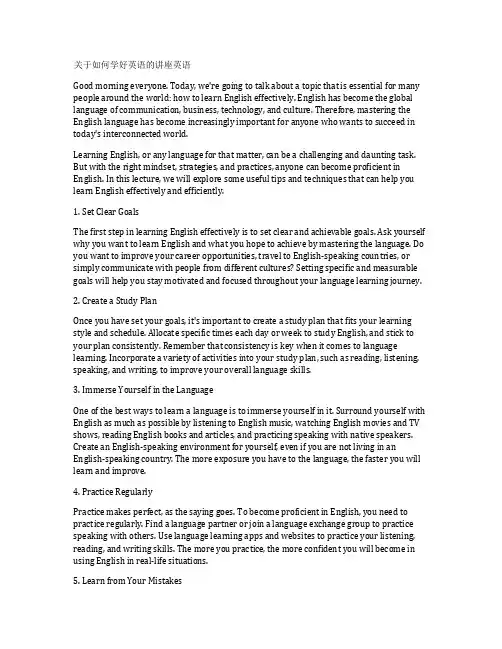
关于如何学好英语的讲座英语Good morning everyone. Today, we're going to talk about a topic that is essential for many people around the world: how to learn English effectively. English has become the global language of communication, business, technology, and culture. Therefore, mastering the English language has become increasingly important for anyone who wants to succeed in today's interconnected world.Learning English, or any language for that matter, can be a challenging and daunting task. But with the right mindset, strategies, and practices, anyone can become proficient in English. In this lecture, we will explore some useful tips and techniques that can help you learn English effectively and efficiently.1. Set Clear GoalsThe first step in learning English effectively is to set clear and achievable goals. Ask yourself why you want to learn English and what you hope to achieve by mastering the language. Do you want to improve your career opportunities, travel to English-speaking countries, or simply communicate with people from different cultures? Setting specific and measurable goals will help you stay motivated and focused throughout your language learning journey.2. Create a Study PlanOnce you have set your goals, it's important to create a study plan that fits your learning style and schedule. Allocate specific times each day or week to study English, and stick to your plan consistently. Remember that consistency is key when it comes to language learning. Incorporate a variety of activities into your study plan, such as reading, listening, speaking, and writing, to improve your overall language skills.3. Immerse Yourself in the LanguageOne of the best ways to learn a language is to immerse yourself in it. Surround yourself with English as much as possible by listening to English music, watching English movies and TV shows, reading English books and articles, and practicing speaking with native speakers. Create an English-speaking environment for yourself, even if you are not living in an English-speaking country. The more exposure you have to the language, the faster you will learn and improve.4. Practice RegularlyPractice makes perfect, as the saying goes. To become proficient in English, you need to practice regularly. Find a language partner or join a language exchange group to practice speaking with others. Use language learning apps and websites to practice your listening, reading, and writing skills. The more you practice, the more confident you will become in using English in real-life situations.5. Learn from Your MistakesDon't be afraid to make mistakes when learning English. Mistakes are a natural part of the learning process and are essential for improvement. Learn from your mistakes and use them as opportunities to identify areas where you need to focus your efforts. Keep a language journal to track your progress, record new vocabulary, and note any errors you make. By analyzing your mistakes, you can become more aware of your weaknesses and work on improving them.6. Seek Feedback and GuidanceIt's important to seek feedback and guidance from others when learning English. Join a language class or hire a private tutor to receive personalized instruction and feedback on your language skills. Participate in language exchange programs or conversation clubs to practice speaking with others and receive constructive criticism. Don't be afraid to ask for help or clarification when you don't understand something. Remember, everyone has to start somewhere, and seeking guidance is a sign of strength, not weakness.7. Stay Motivated and PersistentLearning a new language is a long and challenging process that requires patience, dedication, and persistence. Stay motivated by setting short-term goals, rewarding yourself for your achievements, and celebrating your progress along the way. Surround yourself with positive and supportive people who encourage and motivate you to keep going. Remember that learning English is a journey, not a destination, and every step you take brings you closer to fluency.In conclusion, mastering the English language is a valuable and rewarding skill that opens up a world of opportunities and possibilities. By following these tips and techniques, you can learn English effectively and efficiently. Remember to set clear goals, create a study plan, immerse yourself in the language, practice regularly, learn from your mistakes, seek feedback and guidance, and stay motivated and persistent. With dedication and hard work, you can achieve fluency in English and reach your language learning goals. Thank you for listening, and best of luck on your language learning journey.。
初探小学英语“高效课堂”教学模式英语组贺胃“高效课堂”是我们每一位一线教师永恒的追求。
什么样的课堂才是“高效”的课堂呢?多年来,我们每一位教师都在探索着、实践着。
我想,“高效课堂”主要是指教学过程的最优化,教育效果的最大化。
它是每一位教师不断追求的目标,它体现师生的共同进步,促进知识和素养的共同提高。
在不断的实践探索之中,我们总结出了我校小学英语高效课堂的教学模式,分为准备——呈现、操练——巩固、发展——小结四个部分。
一、准备(warming up/Revision)准备阶段主要是启动和复习阶段,活动的目的是(1)激活学生的大脑和行动,让学生兴奋起来,全部精力投入到本堂课的学习中,即激发兴趣、营造良好的语言学习氛围,拉近师生之间的距离。
(2)激活已学知识。
让已学的知识在学生的大脑中活起来,即复习、巩固和灵活运用已学知识。
准备阶段的形式有:问候、唱歌、闲谈、游戏、故事、表演、等活动。
此时的活动,我觉得最好采用与本节课相关的内容。
一举多得,既起到了热身的作用,又复习旧知,还与本节课的新知识密切相连。
如在人教版英语三年级课本中“Look at me”的教学中,就可以采用Listen touch and say 这样的游戏来热身复习。
又如,在人教版英语五年级课本中,询问学生最喜欢的季节是什么?上课开始,可以让学生先欣赏《Seasons of the song》,既可以创造出浓厚的英语学习氛围,又可以为接下来的导入新课作好准备。
二、呈现、操练(presentation and practice)(一)呈现部分,是一节课的重头戏。
导入要构思巧妙,吸引住学生的视线,抓住学生的心。
所以,我们首先要创设语境,让学生在真实的语境中接触,去体验,去理解。
我们以前的课堂教学是,先讲解生词,然后是句型,最后再来学习会话,而现在,我们的观念要改革了,新的教学理念要求我们进行的是“会话教学”。
那么,在“会话教学”中,我们应该如何呈现新知呢?下面,我以人教版英语五年级“My favourite food”这单元中的“Let’s talk”为例来说一说。
英语学习方法演讲稿:快乐学习,高效学习Ladies and gentlemen,Good afternoon! Today, I am honored to stand here and share with you some effective methods of learning English.English is not only a language but also a key to open the door to the world. Therefore, it is important for us to learn English efficiently and enjoyably.Firstly, it is crucial to set specific goals. Setting clear and achievable goals can help us stay focused and motivated in our English learning journey. Whether it is to improve our speaking ability or to pass a certain language proficiency test, having a clear goal in mind will guide us in choosing suitable learning materials and methods.Secondly, we should create a positive and enjoyable learning environment. Learning should be a pleasure rather than a burden. Find interesting topics or choose materials that match our interests and hobbies. For example, if we like music, we can listen to English songs and try to understand the lyrics. If we enjoy watching movies, we can watch movies with English subtitles and learn new vocabulary and expressions. By incorporating our interests into the learning process, we will not only learn English more effectively but also have fun in the process.Thirdly, it is important to practice regularly. Consistency is the key to success in learning any language. Find a routine that works for us and stick to it. Set aside a certain amount of time each day for English practice, whether it is reading, listening, speaking, or writing. By making English a daily habit, we can improve our language skills step by step.Additionally, it is beneficial to engage in interactive learning activities. Language is a tool for communication, so it is essential to practice communicating in English. Joining English-speaking clubs or finding language exchange partners can provide us with opportunities to practice speaking and listening. Furthermore, participating in group discussions or debates can enhance our critical thinking and argumentation skills in English. These interactive activities not only help us improve our language skills but also build our confidence in using English.In conclusion, by setting clear goals, creating a positive learning environment, practicing regularly, and engaging in interactive learning activities, we can learnEnglish both efficiently and enjoyably. Learning a language should be a joyful process, and when we enjoy learning, we will naturally become more motivated and enthusiastic. So, let us embrace the joy of learning English and unlock the limitless possibilities it can bring to our lives.Thank you for your attention!。
Ladies and Gentlemen,Good morning. My admission number is 32. It’s my pleasure to be here to share my learning designs and ideas with you. Today, I want to talk about my learning designs and ideas about Section B Period 4 of Unit 6 in Book 4. I’m going to analyze the lesson in eight parts.Part 1 Learning Theory BasicAs an English teacher we all know that the main idea of the standard of English Course is: With the course of the teacher, the students can make the aims of activities come true and feel successful by perception, experience, practice and cooperation. So in this lesson, I’ll design some activities and let the students learn the language by communication and cooperation. And let the students feel successful. My learning steps are lead—in, work alone, work in pairs and self—assessment.Part 2 Analysis of the Learning Material1. Status and functionsAccording to PEP Primary English syllabus the students need grasp“”. And learning well in this lesson is very useful for the students to study further when they study Go for it. This lesson is close to the students’ life. So it can arouse the students’ interests.2. Learning Important PointsI can listen, speak, read and write3. Learning Difficult PointsI can use the sentence…correctly and communicate with the classmates. Part 3 Learning AimsI can listen, speak, read and write…I can work in groups and communicate with my classmates.I will enjoy my life better from now on.Part 4 Teaching MethodsTBL teaching method and situational teaching method: The students can make a good communication in real situations.Part 5 Learning MethodsTask—based learning method: the students can finish the tasks to help them get the information.Group cooperate learning method: the students are interested in different kinds of activities. The ability of cooperation will be trained well in this lessonPart 6 Learning AidsMulti—media, the tape, the cassette, some phrase cards.Part 7 Learning StepsStep1 lead in⑴Play the tape “Let’s chant”, let the students listen and chant together.⑵Review some phrase and sentences which have been learned.⑶Introduce learning aims⑷Show the new phrase or word cards. To encourage students try to read.If they are right, they will get the prizes.Design Purpose: Song or chant can form a better English Surrounding for the students. Use the different ways to review the knowledge and raise the students’ interest in learning. And introduce learning aims can let the students know what they will learn. It’s very useful for the next step. Step2: Work alone⑴I can followPlay the tape for the students, let the students follow and make a good habit of listening.⑵I can teachAsk a student to act as the teacher and teach the others.⑶I can learn by myselfLet the students learn by themselves and circle something difficult. Design purpose: Let the students work alone, make a good habit of thinking and studying.Step3 Work in pairs⑴I can readRead the sentences or phrase to your partners, find out the mistakes and correct them.⑵I can teachTeam leader teach the members, and check the members if they can read.⑶I can challengeEvery team leaders check the other team members. There are different kinds of activities, such as translation, reading and so on.⑷I can prepareEvery team practice and prepare to role play.⑸I can practiceLet the team members practice the conversations and phrase.Design purpose: Use different ways to train the target language. Make sure the students can grasp them.Step4 Self—assessmentSome exercises will be given to the students, for example spelling, make up sentences, multiple choices.Design purpose: Check the students whether they master the learning important and difficult points or not.Part8 Blackboard DesignThe learning aims are on the left. The most important sentences are in the middle. And the words are beside the sentence.Design Purpose: I want to make my blackboard simple, direct and helpful so that the students can see and understand the target language clearly.In a word, the design is based on tasks. When the students are carting out the tasks, they can master the main information and the knowledge of this lesson.。
利用“一案一单”导学,打造小学英语高效课堂大庆一中附属机关小学李静一、什么是高效课堂所谓高效课堂,就是学生高效学习和教师高效教学的有机结合。
高效课堂的特点:立体式,快节奏,大容量。
“立体式”即目标任务呈现三维立体式,任务落实到人、组,学生主体作用充分发挥,集体智慧充分展示;“快节奏”即单位时间内紧扣目标任务,周密安排,师生互动,生生互动,达到预期效果。
“大容量”即以教材为基础,拓展、演绎、提升、挖掘课堂活动多元化,力求全体参与体验。
课堂高效的问题,研究及论述颇多。
但有两个基本的描述,即:以尽可能少的时间、精力和物力投入,取得尽可能好的教学效果。
所以,高效课堂可以从以下两个方面来体现。
一是效率的最大化。
也就是在单位时间内学生的受益量。
主要表现在课堂容量,课内外学业负担。
二是效益的最优化。
也就是学生受教育教学影响的积极程度。
主要表现在兴趣培养、习惯养成、学习能力、思维能力与品质等诸多方面。
只有效率的最大化或只有效益的最优化的课堂,都不是真正意义上的“高效课堂”。
只有二者的和谐统一,“高效课堂”才能形成。
简言之,“高效课堂”至少在教学时间、教学任务量、教学效果等三个要素方面有突破,概括为:轻负担,低消耗,全维度,高质量。
二、什么是小学英语高效课堂高效的英语课堂应以学生为中心,教师为主导。
小学英语教学的主要任务是培养学生学习英语的兴趣和积极性;培养学生的学习习惯和学习能力,培养学生的实践能力和交际能力;还要帮他们树立正确的人生观和价值观。
高效的英语课堂,要有效地激发学生的学习热情,使学生“愿学、学会、会学和乐学”。
这就要求教师要制定明确、科学、全面的教学目标,指导调控教学过程;建立融洽的师生关系,创造高效的学习氛围;课堂教学中有效运用导学案,让学生以体验、实践、参与、合作与交流的方式主动学习;给学生自由想象的空间,拓展学生的学习兴趣;优化作业设计,让学生享受学习成功的快乐,增强学习英语的自信心。
三、如何打造小学英语高效课堂(一)我们能做什么?1.研读课标,把握高效课堂的灵魂。
首先要加强对课标的学习、研究。
明确当前教学改革的方向。
2011 版英语课程标准理念更先进,更符合社会发展对人才的需要,修订稿中首次将英语课程的性质界定为具有工具性和人文性双重性质。
更符合语言学习的规律。
修订稿在面向全体学生、突出学生主体、尊重个体差异的基础上,更注重了语言学习的渐进性和持续性。
其次,目标更清晰就小学英语教学而言,修订稿在对原有语言知识、语言技能、情感态度、学习策略、文化意识目标微调的基础上,在技能教学参考中,对各项技能教学的目的、技能要求以及主要活动都给予了分级描述,还明确了小学阶段语法教学的内容与要求。
最后是方法更具体课标对于一线老师而言,不仅是理念的引领,也是方法的指导。
如实施建议中对教学和评价都给出了具体的、符合实际的建议,同时评价方式与方法的举例更为详尽,不仅列举了各项技能不同级别的评价方案,还有对评价方案的评析,对老师们在教学中的评价操作具有很强的指导性。
2.精心备课,是高效课堂实施的关键。
备课是教师上好课的关键,如果备课无效,教学就必然无效。
机关小学从校领导到教导处都十分重视集体备课,每学科每周都有固定的集体备课时间,由陈校长带领学科主任深入各教研组,仔细聆听,及时给予指导和帮助,因此我校的集体备课工作做得扎实而有效。
以英语组为例,每周由一名英语教师对本周的学习内容进行引备,其他年级的教师都踊跃地提出自己的想法,大家各抒己见,集思广益,充分发挥教研组的集体力量。
通过集体备课这个环节可以让老师深入到教材中去,认真钻研教材,准确把握教材,从而创造性地使用教材。
集体备课以后,每位教师针对自己本节课的内容确定重难点,制定出明确合理的教学目标,精心设计教学过程;同时要老师要根据不同年级孩子的特点,充分考虑学生的兴趣和爱好、以及心理特点,制定出符合孩子年龄特点的教学方法。
尤其是备学习单,教师合理地设计出本节课的学习单内容,问题的设置能够激发学生的兴趣,符合孩子的认知规律,从易到难,层层推进,步步提高。
预习作业要难度适中,孩子在家能够独立完成;课上练习要精练,有梯度;不仅仅是习题的罗列,课后作业应是课上内容的补充与延伸。
从而为提高课堂教学效率做充分地准备。
3.使用导学案,是高效课堂实施的载体。
导学案是从学生的角度,从学生的学习实际考虑,帮助并促进他们自学,所解决的重点问题是“学什么”“怎样学”。
陈校长在4月18日给我们做了一次题为《高效课堂——自主学习的殿堂》的讲座。
她在讲座中引入了韩立福教授关于高效教学的一个核心理论是“先学后导、问题评价。
”并把教学过程简单概括为“问题发现、问题生成、问题解决”三个教学环节,这种教学模式在课堂教学中的体现是“一案三单”。
陈校长又从小学生年龄偏小,习惯养成需要培养,能力提升需要过程的小学教学实际出发加以思考,认为“一案三单”在小学阶段不易实施,将“一案三单”改良成“一案一单”,形成了我们机关小学的导学案,即学习方案设计和自主学习活动单,简称“一案一单”。
自主学习活动单包括三个部分:自主学习,我尝试;合作交流,我参与;达标测试,我能行。
自主学习我尝试部分的内容是在课前预习完成,合作交流我参与和达标测试我能行是课上完成,其中合作交流我参与部分是学生分组活动部分,每组学生都是由ABCD四个层次的孩子组成,这个层次是由每节课的评价结果随机组成,呈现循环流动态势。
组内的小组交流后进行集体展示。
整节课将以小组交流研究促进合作学习,以学习活动单为学习杠杆达成学习目标。
4.合作学习,是高效课堂实施的途径。
要调动学生学习英语的积极性,使学生真正成为学习的主人,在学习单的使用过程中,开展小组合作学习是必要之举。
由于小组合作学习必须构建具备一定学习能力的基础之上,所以我校英语目前试行一年感知,二年尝试,三年训练,四年铺开,五年强化的实施方案。
小组合作也是在走由低年到高年循序渐进的建设思路。
同时学校形成了三至五年级自主学习管理制度及考评方案。
通常在我们的教学班级,把四人分成一小组,这样方便前后的孩子进行小组交流。
学习完一个模块以后,可以让小组成员根据本单元内容自编、自演短剧,或编简短的对话,让学生自己分配角色进行表演。
教师还可以把小组交流的内容作为预习的内容提前布置给学生,给学生提供一些相关的背景资料和词汇句式知识,让学生通过查阅资料并结合自己的知识和经验进行有效的信息深加工,然后再进行组内交流、讨论。
这样,学生就有更多的独立思考的时间和空间,在小组互动时就可以避免盲目从众或无言以对,从而培养学生自主学习的能力。
小组合作学习使学生变“苦学”为“乐学”,变“学会”为“会学”,大大提高课堂教学效果,同时也是高效课堂有效实施的一条重要途径。
(二)我们做了些什么?1.2012年3月14日,陈校长给全体教师做了题为《高效课堂—情感共鸣的天堂》专题讲座。
她从“为什么要打造高效课堂,什么是高效课堂,怎样进行高效课堂的研究与实践”三个方面进行了阐述。
整个讲座贯穿陈校长对于高效课堂研究的个人思想,是其理论研究与教学指导及实践经验的有机融合。
让在座的每位老师对高效课堂有了更深一步的理解,也打开了我们思维的大门,为我们下一步的课堂实施提供良好的理论基础及方向指导。
在此基础上,陈校长又于4月18日进行了第二次专题讲座《高效课堂—自主学习的殿堂》,两次讲座让所有的任课教师受益匪浅,以下是我校英语考研组在听取完陈校长的讲座以后,以年级为单位,每个年级提交的“一案一单”设计。
在她的理念引领下,我校形成了自己的高效课堂模式,即“分层合作探究,一案一单导学”。
2. 本学期为了更好地推进和开展英语学科的高效课堂研究活动,英语教研组又于10月15、16、17日三天进行了三节高、中、低年级的英语课堂展示活动,这三节课集中体现了我校英语课的高效、扎实、有效的特点,三位老师在备课的时候都能根据孩子的年龄特点设计教学内容,容量恰当,难易适中。
而且在教学过程中每位教师都能够有效合理地使用学习方案以及自主学习活动单,体现对学生学习习惯,学习兴趣和自主探究意识地培养。
学生在学习过程中也真正实现了自主,合作,探究的学习目的。
三节课后全体英语教师认真地聆听了任课教师的课后反思,分别提出了自己的看法和建议,同时陈校长也给予了高度的评价。
3.2012年11月根据一中整体教学安排,把高效课堂落到实处,一中举办了第十六届“红烛奖”教学活动。
英语学科我校选派了优秀的骨干教师孙丽恒执教上课。
她所执教的《I t’s winter》一课,首先从教学设计上看,她能够有效地使用学习方案,“一案一单”的设计合理,使用恰当。
由于这节课新词和新句型偏多,所以在学习单的设计中,可以让学生在家先进行听读和季节单词的预习。
学生们在家长的配合下,都很好的完成了预习任务,课前她对学生的预习作业进行细致的检查和认真的批阅,并给予及时和充分的评价。
课程进行过程中她又设计了合作交流,我参与的学习环节。
活动单上面准备了读读选选的练习,让学生马上进行知识的巩固与反馈。
练习过后,进行小组合作活动。
让学生学会合作学习,通过大家喜爱的卡通形象沸洋洋来呈现出讨论的问题:在每个季节都做什么。
进行了课文的拓展和延伸。
让学生通过讨论来完成表格。
活动单的完成,丰富了课堂的内容,提高了课堂的效率,最大限度的扩充了规定时间内的课堂容量与训练力度。
问题的出现恰到好处,问题的设置难易适中,符合孩子的认识规律,激发孩子的讨论热情,提高了孩子们的学习兴趣,真正达到了课堂的高效。
在达标测试,我能行环节,她在活动单的设计上又提高了一个梯度,因为有课堂句子做铺垫,所以她大胆尝试让学生们动手去写一写你所喜欢的季节,以及你在这个季节所做的事情。
整个教学过程彰显了我校的“高效课堂,一案一单”教学理念及教学风格。
(三)研究过程中遇到的困惑我们在实施“高效课堂,一案一单”的教学过程中,也有一困惑,这是我们将一直深入研究的问题,这两个研究问题也将伴随我们长期的研究进程。
1、如何使用“一案一单,达到课堂教学效益的最大化。
“自主学习活动单”应该怎么用,何时用才能更为合理,更为有效。
2、如何开展小组合作学习,达到充分地合作学习与交流。
英语课堂的小组活动形式多样化,但并非每个小组成员都能积极地参与到活动中来,有时在讨论过程及合作交流的环节只有少数优秀生参与表现,大部分学生并没有真正地参与到活动中来,同时也降低了课堂的教学效率。
所以小组建设工作任重道远。
陈校长提出,当用则用,无用则弃,用精,用妙,不适合可不用。
不要整齐化一,生搬硬套,简单盲从。
她的思想令我们茅塞顿开。
四、机关小学英语教学的努力方向(一)进行扎实有效的语篇教学,为高效课堂奠定基础1、整体感知,打好语篇教学的基础。
在传统的英语教学中,教师往往先教单词,再学说句子,然后让学生跟读二遍课文,就开展各种各样的活动。